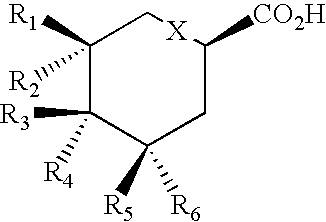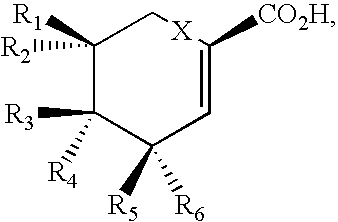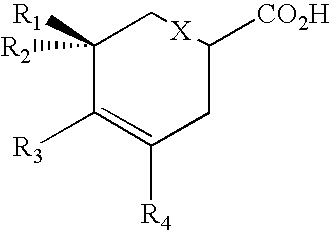Production of polyketides and other natural products
a technology of polyketide and natural products, applied in the field of polyketide and other natural products production, can solve the problems of limited utility of the approach, difficult work, and less success of the biological approach to producing novel rapamycin analogues
- Summary
- Abstract
- Description
- Claims
- Application Information
AI Technical Summary
Benefits of technology
Problems solved by technology
Method used
Image
Examples
example 1
Conjugation of S. hygroscopicus
[0359] The plasmid to be conjugated into S. hygroscopicus was transformed by electroporation into the dam− dcm− ET12567 E. coli strain containing either pUB307 as described in MacNeil et al. (1992) or pUZ8002 as described in Paget et al. (1999). A preculture was used (over night culture, 30° C.) to inoculate fresh 2xTY (with 50 μg / ml apramycin and 25 μg / ml kanamycin) at a dilution of 1 / 25 and grown with shaking at 37° C. to an optical density at 595 nm of 0.25-0.6. The cells from this broth were washed twice with 2xTY, then resuspended with 0.5 ml of 2xTY per 25 ml original culture. The quality of the spore stock used is critical for the success of this method. In this context the age of the spores when harvested and the use of medium 1 are crucial for the isolation of high-quality spore suspension. To isolate high-quality spore suspensions of S. hygroscopicus, pre-dried plates of medium 1 agar (see Materials and Methods section) were spread with S. h...
example 2
Isolation of the S. hygroscopicus Mutant MG2-10 Carrying the Chromosomal Deletion of rapQONMLKJI (FIG. 4).
[0361] An S. hygroscopicus mutant (MG2-10) in which the rapamycin modifying genes rapQ, rapO / N, rapM, rapL, rapK, rapJ and rapI were deleted was constructed as described below.
Isolation of the Streptomycin Resistant Mutant MG1C:
[0362]S.hygroscopicus NRRL5491 mycelia were spread onto plates of medium 1 containing 50 mg / ml streptomycin. Three colonies were isolated and labelled MG1A, MG1B and MG1C. These were conjugated as in example 1 with the plasmid pMG49, a derivative of pSET152 containing the rpsL gene from S.lividans TK24. Exconjugants from each of these conjugations were patched onto a plate if medium 1 containing 50 mg / ml apramycin and 50 mg / ml nalidixic acid, to confirm the presence of the plasmid pMG49. They were then streaked, along with the original strains MG1A, MG1B and MG1C, onto a both a plate of medium 1 containing no antibiotic and a plate of medium1 containi...
example 3
Expression of rapK in the S. hygroscopicus Mutant MG2-10 Carrying the Chromosomal Deletion of rapQONMLKJI (FIG. 4)
Construction of Expression Vector pSGset1
[0366] The pSET152 (Bierman et al., 1992a) derived vector pCJR336 (kindly provided by Christine Martin and Corinne Squire) was created by cloning the primer dimer of CR347 5′-TAAACTAGTCCATCTGAGAGTTTCATATGGCCCTATTCTGCCCAGCCGCTCTAGAAAT-3′ (SEQ ID NO: 35) and CR348 5′-ATTTCTAGAGCGGCTGGGCAGAATAGGGCCATATGAAACTCTCAGATGGACTAGTTTA-3′ (SEQ ID NO: 36) into PvuII digested pSET152 using standard molecular biological techniques, thus introducing sites for the restriction enzymes SpeI, NdeI, and XbaI into pSET152. The orientation of the insert was confirmed by sequencing. Plasmid pCJR336 was digested using the restriction enzymes NdeI / SpeI and vector pSG142 (Gaisser et al., 2000) was digested identically. The resulting DNA bands of about 5.4 kb for pCJR336 and 1.2 kb for pSG142 were isolated followed by a ligation which was used to transform...
PUM
| Property | Measurement | Unit |
|---|---|---|
| Fraction | aaaaa | aaaaa |
| Fraction | aaaaa | aaaaa |
| Fraction | aaaaa | aaaaa |
Abstract
Description
Claims
Application Information
 Login to View More
Login to View More - R&D
- Intellectual Property
- Life Sciences
- Materials
- Tech Scout
- Unparalleled Data Quality
- Higher Quality Content
- 60% Fewer Hallucinations
Browse by: Latest US Patents, China's latest patents, Technical Efficacy Thesaurus, Application Domain, Technology Topic, Popular Technical Reports.
© 2025 PatSnap. All rights reserved.Legal|Privacy policy|Modern Slavery Act Transparency Statement|Sitemap|About US| Contact US: help@patsnap.com



